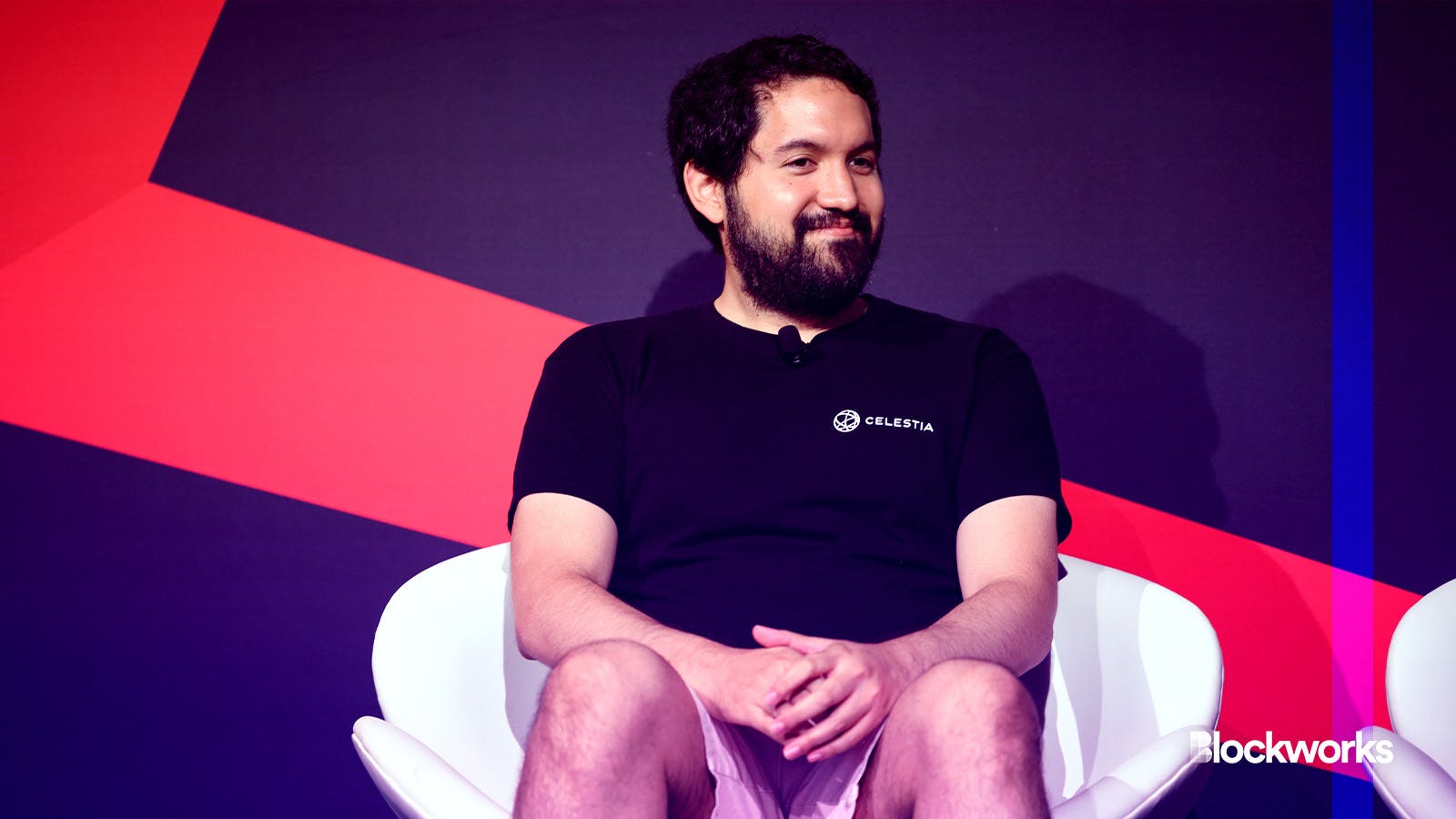Manta Pacific adopts Celestia, embraces native Ethereum yield
Manta Pacific becomes first layer-2 to transition to Celestia for data availability, while offering Ethereum staking yields

Celestia co-founder John Adler | DAS 2022 New York by Blockworks
Manta Pacific, a layer-2 network currently running on Optimism’s OP stack, has become the first such chain to adopt modular data availability (DA) using the newly launched Celestia mainnet.
The shift to Celestia for DA, instead of Ethereum mainnet, is expected to make transactions for Manta Pacific cheaper by at least an order of magnitude, according to core contributor Kenny Li, which should “future-proof” the chain even if demand for block space picks up in a future bull market.
Currently, a typical transaction costs around $0.24 on Manta Pacific, but Li anticipates that they can reduce that to less than $0.03 within a week or two, and a 25x savings after further adjustments in January.
Read more: Celestia, the first modular data availability network, launches on mainnet
Li, who co-founded p0x Labs, which is developing Manta Network, started talking with the Celestia team in the first quarter of 2023, after learning that Celestia was working on an OP stack integration, which timed out well with Manta’s launch plans.
“By coincidence, we were able to kind of get the stars aligned there — no pun intended,” Li told Blockworks.
Manta Pacific’s integration with Celestia utilizes data availability sampling (DAS), a mechanism that allows light nodes to verify data availability without downloading all data within a block. This method reduces costs by enabling more efficient data retrieval, effectively turning the rollup into a validium.
Read more: So your layer-2 is ‘secured by Ethereum’ — what does that mean?
The adoption of modular blockchain designs involve a separation of various tasks — such as consensus, execution, data availability and settlement — across different layers, rather than handling all functions within a single chain.
Since the launch of the Manta Pacific testnet in August, the Manta team decided to switch to a zkEVM based on the Polygon Chain Development Kit (CDK).
Polygon’s own proof-of-stake chain will also migrate to a zkEVM validium rollup.
This transition, which should take place in the second quarter of 2024, will solve the user pain point of delayed withdrawals required by the fault proofs endemic to Optimistic rollups.
“Right now, we’re looking at, first, phasing it in such that one of our phases would essentially have a multi-prover model whereby we could fall back to the fault proofs on the OP stack if anything went wrong, but also being able to bring in the zk proofs so that we can have that fast finality for the users,” Li said.
Fault proofs on Optimism are not yet live, so the integrity of transactions relies on trusting a centralized sequencer and community vigilance.
Manta also relies on one centralized sequencer to post data to Celestia, and Li analogizes the planned zk-prover fallback mechanism to the use of Celestia itself.
“The components we need to think about [are] resiliency, fallback options, contingency plans, and so with Celestia, the contingency here is that the fallback goes back to Ethereum” for data availability, Li explained.
Since DA is the main driver of transaction costs for the user, a multi-prover system should have a negligible effect.
P0x Labs, the team building the Manta Network, wrapped up a $25 million Series A funding round in July.
Manta Pacific joins Manta Atlantic, a Polkadot parachain expected to go live in early 2024, to collectively offer a multifaceted option for the development of Web3 applications.
Read more: Polkadot rethinks the economics of parachain auctions
Manta Atlantic focuses on zk solutions within the Polkadot ecosystem, but Li said there are synergies between the two coming.
“A lot of the zk components that we built out on the circuit side specifically are focused on on-chain identity, and so one of our goals right now is to bridge that on-chain identity over to the Pacific ecosystem so that people can verify without revealing any of their wallet addresses and stuff,” he said.
That would include roughly 100,000 KYCd participants, he added.
Native yield on ETH and USDC
Manta Pacific offers its own spin on the idea pioneered by Mantle and Blast to let users earn yield on their deposited ether and stablecoins while interacting with dapps on the layer-2 network.
Read more: Mantle offers ‘mETH’ to the masses, as a ‘lighter weight Lido’
Manta relies on StakeStone a Liquid Staking Token (LST) protocol that accepts ETH and issues STONE, a non-rebasing Omnichain Fungible Token (OFT) based on the LayerZero protocol, which can be used directly in DeFi dapps.
StakeStone supports leading staking pools and is compatible with upcoming restaking, such as EigenLayer.
Similarly, USDC deposits are converted to the yield-bearing stablecoin (USDM) issued by Mountain Protocol. Manta will eventually enable bridging these tokens back out after an initial phase of about two months as part of a campaign, dubbed New Paradigm.
And that’s exactly how Li sees it.
“Kudos to Blast — they’ve got like 800 million TVL [total value locked] from people who could otherwise be using those assets in ways that could provide more future value,” Li said, adding that Manta Pacific’s TVL is about $60 million after 3 days.
“I do know that many other [layer-2s] are also exploring this now as well, and I think while it’s interesting and novel at this moment, a year from now, I wouldn’t be surprised if it’s a commodity — the feature that everyone has,” he said.
Get the news in your inbox. Explore Blockworks newsletters:
- The Breakdown: Decoding crypto and the markets. Daily.
- 0xResearch: Alpha in your inbox. Think like an analyst.






